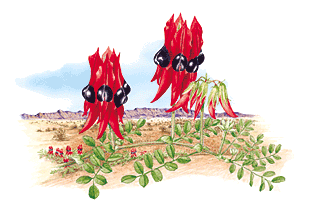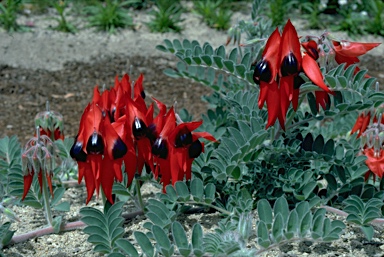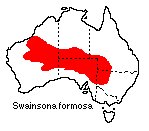 Sturt's
Desert Pea
Sturt's
Desert Pea
Swainsona formosa
(plant family: Fabaceae)
Floral Emblem of South Australia
Sturt's Desert Pea, Swainsona formosa, was adopted as the floral emblem of South Australia on 23 November 1961, using the name Clianthus formosus.
This species, a member of the pea family, Fabaceae, is confined to Australia, where it occurs in all mainland States except Victoria. The original collection was made in 1699 by William Dampier on Rosemary Island in the Dampier Archipelago where he collected a specimen from:
"a creeping vine that runs along the ground ... and the blossom like a bean blossom, but much larger and of a deep red colour looking very beautiful".
This specimen is now housed in the Sherardian Herbarium, Oxford. The species was for many years included in the genus Clianthus now thought to be confined to New Zealand.
 Captain
Charles Sturt (1795-1869) noted the occurrence of Swainsona formosa in
1844 while exploring between Adelaide and central Australia, and the common
name, Sturt's Desert Pea, commemorates a notable explorer of inland Australia,
as well as indicating the plant's habitat and family. Sturt's journal, Narrative
of an Expedition into Central Australia, refers several times to the beauty
of the desert pea in flower and the harsh nature of its habitat, and notes that
beyond the Darling River:
Captain
Charles Sturt (1795-1869) noted the occurrence of Swainsona formosa in
1844 while exploring between Adelaide and central Australia, and the common
name, Sturt's Desert Pea, commemorates a notable explorer of inland Australia,
as well as indicating the plant's habitat and family. Sturt's journal, Narrative
of an Expedition into Central Australia, refers several times to the beauty
of the desert pea in flower and the harsh nature of its habitat, and notes that
beyond the Darling River:
"we saw that beautiful flower the Clianthus formosa [sic] in splendid blossom on the plains. It was growing amid barrenness and decay, but its long runners were covered with flowers that gave a crimson tint to the ground".
The genus name Swainsona honours Isaac Swainson who maintained a private botanic garden at Twickenham near London about the year 1789. The specific name formosa is Latin for 'beautiful'. The original author of the species was the Scottish botanist, George Don (1798-1856).
In its natural habitat Sturt's Desert Pea is a perennial plant with silky grey-green pinnate foliage arising from prostrate stems. The leaves and stems are covered with downy hairs. The flowers are about 9 cm long and arranged in clusters of six to eight on short, thick, erect stalks. The petals are usually blood red or scarlet with a glossy black swelling or 'boss' at the base of the uppermost petal, the standard. Other colour forms range from white to deep pink, either with or without a black boss, and rarely a bicoloured form, in which the standard is scarlet and the other petals, the wings and keel, are white tipped and edged with scarlet. The fruit is a legume about 5 cm long which splits at maturity releasing several flat kidney-shaped seeds.
 Sturt's
Desert Pea occurs in arid woodlands and on open plains, often as an ephemeral
following heavy rain. It is able to withstand the marked extremes of temperature
experienced in inland deserts, and light frosts are tolerated by established
plants.
Sturt's
Desert Pea occurs in arid woodlands and on open plains, often as an ephemeral
following heavy rain. It is able to withstand the marked extremes of temperature
experienced in inland deserts, and light frosts are tolerated by established
plants.
Sturt's Desert Pea is protected in South Australia. The flowers and plants must not be collected on private land without the written consent of the owner. Collection on Crown land is illegal without a permit.
The hard seed coat of Sturt's Desert Pea inhibits germination. This effect can be overcome by filing or nicking the seed coat away from the 'eye' of the seed; alternatively, the seed may be rubbed gently between sheets of sandpaper. Soaking the seed in warm water gives variable results, Boiling water should not be used as it destroys beneficial bacteria on the seed coat. Since the seedlings develop a long tap root and do not tolerate root disturbance, treated seeds should be planted directly into the chosen garden site or container, or alternatively into small pots for transplanting soon after germination.
Full sun, perfect drainage and protection from snails are essential. Supplementary watering may not be necessary once the seedlings are established. Under ideal conditions flowering commences about four months after germination. Sturt's Desert Pea is usually treated as an annual but vigorous flowering may result if root crowns survive from one season to the next. Alternatively, it may be grown in large drums, tubs and upright terracotta drainpipes which allow adequate root development.
Swainsona formosa was introduced to England in 1855. It proved difficult to grow on its own roots, but grafted on to Colutea arborescens, Bladder Senna, it produced an admirable plant for hanging baskets.
Tissue culture is also used to propagate Sturt's Desert Pea. Small pieces of stem tissue are grown on a nutrient medium under sterile laboratory conditions. This method produces large numbers of identical plants from a small amount of parent tissue and is a means of maintaining unusual colour forms.
Sturt's Desert Pea was depicted on the 20 cent stamp [illust] designed by Dorothy Thornhill as part of a set of six stamps issued on 10 July 1968, featuring floral emblems of the Australian States. The South Australian emblem was repeated on the 7 cent [illust] and 10 cent stamps, two of a set of six stamps issued on 1 October 1971 and 15 January 1975 respectively.
The distinctive shape of Sturt's Desert Pea makes it ideal for use on insignia, and on decorative items where it is readily identified either in realistic or stylised form. The armorial bearings of South Australia include two crossed branches of wattle at the base of the shield. These bearings, which were granted in 1936, the Centenary Year, do not include the floral or faunal emblems of the State.
Download a line illustration by Marion Westmacott.©
Download copyright-free illustration by Fay Davies, suitable for childrens' colouring.
Written by Anne Boden for a booklet published by AGPS for the ANBG in 1985.
![An Australian Government Initiative [logo]](/images/austgovt_brown_90px.gif)







